Let’s take a look at why you need to use preschool printables over preschool worksheets. The distinctions are so important.
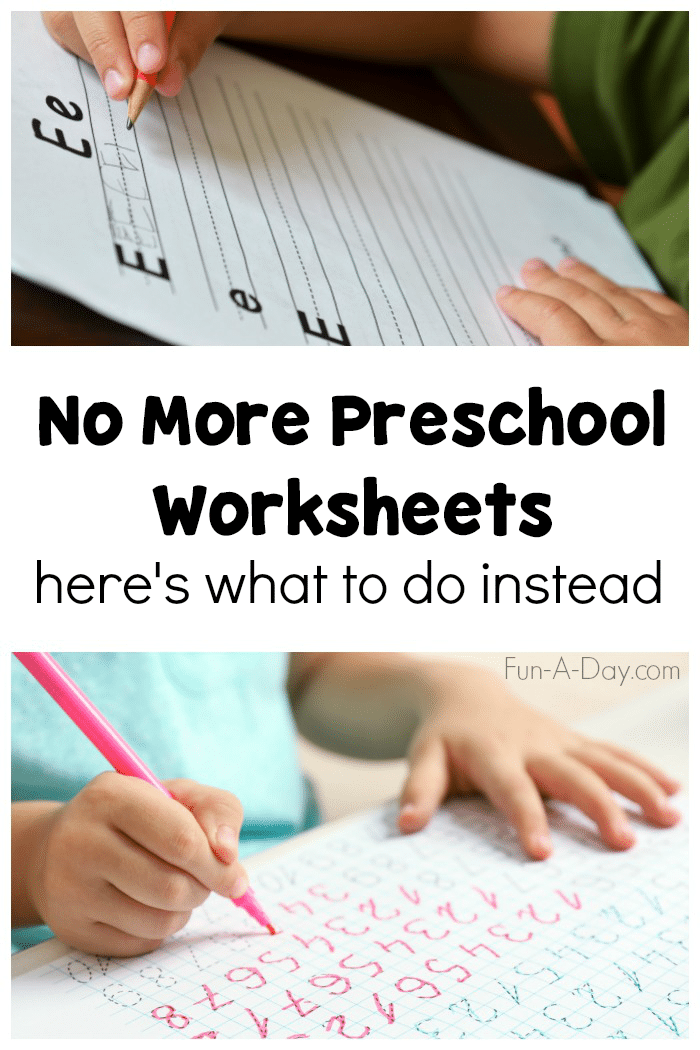
Related: Your Most Important Teaching Resource
I’m not a big fan of worksheets.
Okay, that’s an understatement. I firmly believe that worksheets don’t belong in early childhood classrooms.
That might annoy some of my fellow early educators, but it’s true.
I do, however, like using some printables alongside hands-on, multi-sensory learning activities.
Because of that preference, I’ve heard the question, “How is a printable different than a worksheet?” Let’s take a look that now.
What are Preschool Worksheets?
Keep in mind, this is how I personally define the term “worksheet”. While I know others think of worksheets the same way, I can’t 100% say this is the definitive explanation for the term.
Worksheets consist of just paper and pencil work (or other writing implements, of course).
- Tracing or writing a letter over and over
- Drawing lines from pictures to numbers
- Marking lines from uppercase to lowercase letters
- Circling the picture that’s the correct color
- Etc.
Repetitive writing on two-dimensional paper, without the use of anything beyond the paper and the writing tool.
What’s So Wrong with Using Worksheets in Early Childhood?
I feel like I should stress that I’m not judging other educators who use worksheets.
I disagree with their use on many levels, but this isn’t coming from a place of judgement. This is coming from a place of explanation.
The more we, as educators, talk about polarizing topics and share real information, the more educated we all become.
Which means more educators using best practice in the classroom.
Now that I’ve made that point, onto some of the reasons why I think worksheets don’t belong in preschool or kindergarten classrooms.
Preschool Worksheets are Two-Dimensional.
I mentioned this above, but the comment deserves a bit more explanation.
Worksheets are, of course, flat. The activity all takes place on the piece of paper, within the context of written words and printed pictures.
Young kids learn in more than one way, and hands-on activities are important to that learning.
Kindergarten and preschool worksheets generally don’t account for learning beyond looking and writing.
They’re definitely not giving the kids anything to really put their hands on to manipulate.
Worksheets Don’t Engage the Other Senses
This point is very much related to what I said above.
Worksheets definitely engage the sense of sight. But that’s about it.
If you want to be technical, the sense of touch is involved when it comes to using a pencil or crayon to complete the worksheet. But that isn’t really using the sense of touch to learn, so I won’t count it.
Worksheets don’t allow for children learning with their senses of hearing, smelling, touching, or tasting.
Since young children need multiple senses engaged when learning, worksheets fall very short from meeting that need.
Worksheets Have One Answer
There’s usually just one way to complete a preschool worksheet.
It doesn’t allow for the deviations of thinking and learning the children need.
On top of that, worksheets don’t encourage problem solving. If there’s only one correct answer, why take a chance and try something in a new way?
This doesn’t do anything to encourage higher-level thinking. Children catch on quickly that, if they don’t give the right answer, they’ve done the worksheet wrong.
Yes, there are some things that have just one answer. One plus one will always equal two.
However, there are so many more things that don’t have just one answer. For example, there’s more than one way to get that answer two in a math problem (1+1, 0+2, 2+0).
Worksheets are Abstract
The written word, in itself, is abstract.
During early childhood, children begin learning how to move from the concrete (a ball in hand) to the abstract (the word ‘ball’ written on a page).
So, in and of itself, abstractness in early childhood isn’t a “bad” thing.
However, worksheets are pretty much all abstract.
There’s nothing concrete that can help scaffold children’s understanding of a concept.
Preschool Worksheets are Stagnant.
When you think of filling in a worksheet, what image comes to mind?
Probably a kiddo sitting in a chair at a desk, head bent as she writes on a piece of paper.
Children are generally sitting still as they use worksheets. Of course, there’s nothing wrong with a kid sitting at a desk writing.
But young children don’t need to be sitting in a chair throughout the learning process.
They should be able to move often, sit in different positions, move about, etc. Worksheets don’t really allow for that.
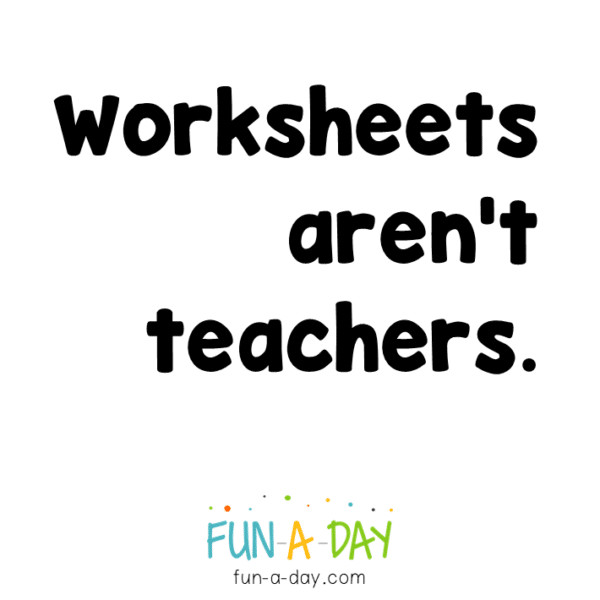
Worksheets aren’t Teachers.
As a teacher, it’s my job to guide a child’s learning in developmentally appropriate ways.
I can ask higher-order thinking questions, differentiate the learning for different students’ needs, hold a conversation with kids, listen, observe, etc.
All of the zillions of things that go into teaching young children. Worksheets can’t do that. They aren’t teaching children anything.
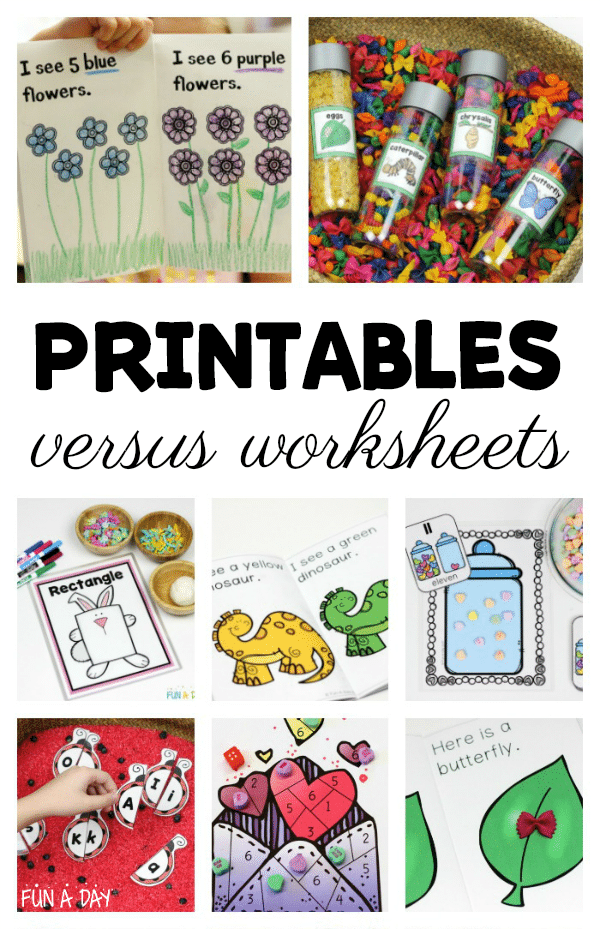
Related: Online Professional Development for Teachers
How are Preschool Printables Better Than Preschool Worksheets?
Now that I’ve expounded on about why worksheets don’t belong in early childhood classrooms, let’s take a look at the use of printables in preschool.
What is a Printable Anyway?
Again, I need to point out that this is my definition of the term. Others may have a slightly different thought on the matter.
Printables are papers and activities that (obviously!) need to be printed.
They’re meant to be used alongside hands-on activities and require more than just paper-to-pencil work.
For example, I created a set of printable robot number cards are meant to be used with a robot sensory writing tray.
Printables are Used Alongside Hands-On Activities.
As I just mentioned above, printables are used with hands-on activities.
Preschool worksheets tend to be used in place of hands-on activities.
Printables allow for kids’ needs to touch, manipulate, and explore as they’re learning and playing.
Some printables can even be made into three-dimensional objects, like number cubes, that are used with early learning activities.
Preschool Printables are Used Alongside Multi-Sensory Activities.
Yes, printables only engage the sense of sight and sometimes the sense of touch. They don’t include hearing, taste, and smell.
However, they can be used with lessons that touch on all of children’s senses.
For example, a five senses recording sheet about pumpkin pie. The printable is just a tool while the children explore the pumpkin pie with all of their senses.
Printables Can Help Bridge the Gap Between Concrete and Abstract.
Children are learning to move from concrete to abstract in preschool and kindergarten.
Printables can help with that process. The pumpkin pie recording sheet I mentioned above helps with just that.
Kids explore real, meaningful, concrete activities.
Then, using printables, they can move to the abstract by writing letters and words (or drawing pictures, depending on their skill level).
Kindergarten and Preschool Printables Aren’t Used Stagnantly.
There isn’t always just one way to use kindergarten and preschool printables.
Kids don’t always have to be sitting down at a table or a desk to make the most of the printable activities.
In fact, some of them may encourage getting up and moving around. If not, teachers can easily change up how they’re used to include movement for the kiddos.
One example of this are editable printable home activity calendars (for teachers who are mandated to sign some kind of homework or to give to families who are looking for age appropriate ideas for after school).
Printables Aren’t All About the Answers.
While preschool worksheets generally only have one answer, printables tend to have more than one way to use them. Therefore, more than one acceptable answer.
This allows for more problem-solving by the children, and it also gives more room for working on higher-order thinking skills.
This book of structures printable for the block center is a prime example. It can be used to inspire new creations in the block center, talk about different countries, and when discussing engineering. It also can be used as a prompt for the question, “How do you think we could build something like this with what we have?”
Printables Allow for More Student-Teacher Interactions
Just like worksheets, printables aren’t teachers. No paper will replace a teacher’s interactions with her students (or a parent’s interactions with his kiddos)!
However, printables allow for more of those interactions.
With worksheets, a teacher can read the directions, explain what to do, and then maybe point out the correct answer.
Since printables are meant to act alongside hands-on lessons, teachers have more room to get involved with the children.
I feel like I should also note that preschool and kindergarten lessons should be meaningful to the kids, with attention paid to how each child learns.
Printables, like most things, should be used in moderation (while I think preschool worksheets shouldn’t be used at all).
And they should be used in conjunction with free exploration, hands-on activities, and lessons that appeal to a variety of senses.
Do you use kindergarten or preschool printables in the classroom?
What are some of your favorite ways to incorporate them with hands-on, mutli-sensory learning activities?
Hands-On Preschool Materials
Since we are reducing our use of worksheets in preschool, it’s imperative that we have our classrooms stocked with tons of great hands-on materials for the students to use. Listed below are a few things I always keep on-hand in my classroom (I may get commissions for purchases made through links in this post):
- Crayons
- Glue
- Blocks
- Puzzles
- Safety scissors
- Dramatic play items
- Math manipulatives
- Dry erase markers
- Sensory items
- Play dough
- Craft supplies
- Playground balls
- Music and movement tools
- Books, books, and more books!
When it comes to preschool, this list is really just skims the surface of the wide variety of materials that can be used. The best thing about this age group is that they learn the most while playing. So, whether they’re playing on the playground, building with blocks, or creating a masterpiece, rest assured that the children are learning so many important skills all while having fun!
More Reading for You
If you want to read other articles on this topic of going without preschool worksheets, here are a few I found after writing this one:
- 7 Ideas for Replacing Worksheets from Wonder Teacher
- The Worksheet Dilemma from Sue Grossman
- Explaining Developmentally Appropriate Practice to Families from NAEYC
Preschool Printables and Lesson Plans
If you’re looking for meaningful preschool printables that can be used with hands-on activities, you need to check out Preschool Teacher 101. It is filled with hundreds of preschool lesson plans, math and STEM activities, literacy lessons, and preschool teacher resources.
Members of The Pack from Preschool Teacher 101 have access to these resources, as well as a variety of trainings and assistance from two seasoned early childhood educators.
An Awesome eBook for Teaching Kids Letters and Numbers
I absolutely adore this eBook. Yes, I’m a little biased since I worked together with other parents and teachers to create it. That doesn’t mean it isn’t amazing in its own right, of course! ABCs and 123s is full of 40+ kids’ hands-on activities for learning the alphabet and numbers. Each activity is kid-approved and geared towards children ages 2 to 8. Grab the eBook now.
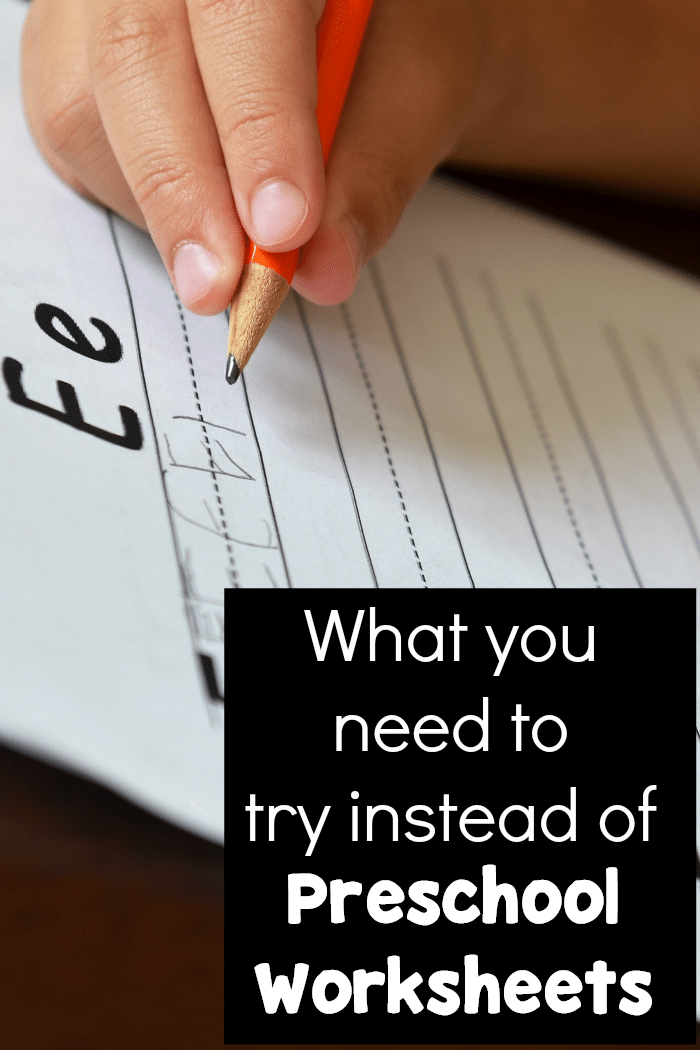
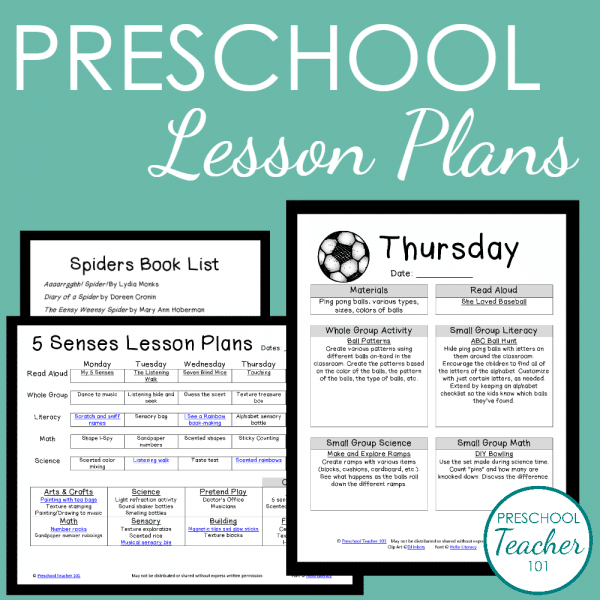

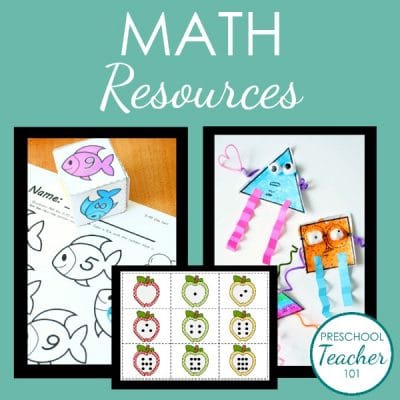
Leave a Reply